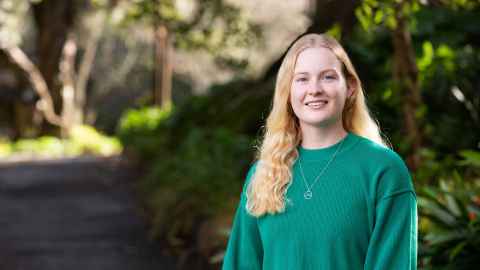Using technology to protect our planet
28 September 2022
Taryn Smith has found studying GIS and Environmental Science to be a perfect blend of discovering the natural world and how to safeguard it.

Through her studies, Taryn Smith says she has been able to explore and understand the world’s complex natural and social processes, problems the world is facing and importantly how people can be the solution.
“I’ve always had a passion for the environment; growing up with hobbies that constantly had me in the outdoors made me want to learn about and explore the physical world around me,” says Taryn. “The more I progressed in my high school studies, I found that I also had a passion for technology, problem solving and understanding the role that humans play within the environment, particularly sustainability.”
Her undergraduate double major choice of Geographic Information Science and Environmental Science has enabled her to combine all these ideas together.
“The evolution of technology we have access to in today’s world has continued to fascinate me. Pursuing the GIS major allowed me to see the world in a different way and provided a new level of comprehension around the world’s spatial patterns, relationships, trends and changes,” she explains.
“In my studies, I have been able to understand the various ways we can analyse and manipulate spatial information across a broad range of topics, and to also provide a backbone for decision making and innovative future-proof solutions.
“Learning the theoretical and practical skills behind the ways we can integrate GIS and Environmental Science into everyday business, policy and communication both locally in New Zealand and globally, has provided me with a stepping-stone towards a career that can make a difference.”
In my studies, I have been able to understand the various ways we can analyse and manipulate spatial information across a broad range of topics, and to also provide a backbone for decision making and innovative future proof solutions.
Taryn enjoys the various modes of learning in her studies and focus on practical skills rather than solely traditional assignment styles.
“Even if you have many passions, you’ll be able to gain new insights and ways of showcasing them through learning and understanding GIS, as there are so many opportunities to use creativity and merge your own ideas and interests into practical assignments.”
Although the majority of her studies were taught online as a result of the pandemic, she was always able to connect virtually with her fellow students, lecturers, and tutors.
“We were always able to get in contact and ask questions, receiving a bunch of support. What I have appreciated most is the dedication of the educators (both tutors and lecturers) to better our learning and helping us to achieve the best we each can.”
She also found the Career Development and Employability Services (CDES) at the University to be very supportive, providing information on useful events and career planning sessions including interview practice.
“They have helped me to find opportunities and companies I might be
interested to work for in the future, tips to prepare for meeting employers and general advice that everyone should have moving through their studies.”
Outside of her studies, Taryn says the Science faculty’s extracurricular activities were a great way to make friends and explore interests, whether it be a hackathon, quiz night or clubs and career events.
“I found that GIS is still a relatively niche field, and all of the students in the programme are friendly, helpful and engaged with learning and activities – which only makes it easier for you to get involved.”
inSCight
This article appears in the 2021 edition of inSCight, the print magazine for Faculty of Science alumni. View more articles from inSCight.
Contact inSCight.